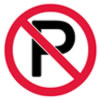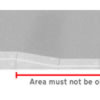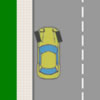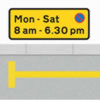Now local councils manage parking and parking restrictions with their boroughs, long gone are the days where a motorists can pull up at the side of the road for a few minutes without being issued a parking ticket.
This section details motor vehicle parking restrictions and contravention laws for the various UK road markings and signs.
With the seemingly never ending parking regulations set out by the government and local councils, it can be a little unclear where you can and cannot park legally.
Explained are road markings that prohibit parking permanently, those that are part time, roads and markings that are legal or illegal to park on, plus the potential fines incurred when a driver receives a Penalty Charge Notice (PCN), or Fixed Penalty Notice (FPN) from the police.

Can you park on single yellow lines
Many thousands of UK motorists are fined each year for parking on single yellow lines. This guide explains the laws and restrictions for parking on single yellow lines, when it is permissible to park on lines, plus the potential parking fines incurred when being issued a Penalty charge Notice.

Parking on pavements Laws
For many, parking on the pavement might seem like no big deal. Due to the impact on vulnerable pedestrians however, new government laws introduced making parking on the pavement an offence for many areas. Offered are parking tips to avoid fines.

Dropped kerb parking Law
Whether parking across a dropped kerb intentionally or unintentionally, the police and local authorities have the power to issue parking tickets. Explained are the rules for parking close to a dropped kerb to avoid tickets and what to do if vehicles persistently park over your driveway.

Parking on a hill
Although modern vehicles stronger and more reliable components compared to those of old, occasionally they still fail. Whether parking uphill or downhill, a few simple safety precautions can be taken to ensure minimal risk of an accident in the event your vehicles parking brakes fail.

Nearest you can park to a junction
Many drivers either park their vehicle too close or opposite a junction either because they’re not aware of certain regulations, or that there’s simply nowhere else to park. Though there isn’t an official offence for parking too close to a junction, it’s still possible to obtain a Fixed Penalty Notice if it’s seen that you’re obstructing others.

Parking on double yellow lines Law
Double yellow lines by law operate a permanent no waiting restriction. Although parking (defined as exiting and leaving your vehicle) is prohibited, it entitles a driver to stop and set down or pick up passengers under certain conditions. Other exceptions such as loading are permissible.

Parking at night and the Law
Although many of us do not follow parking at night laws for cars, there are certain roads and vehicles parking during the night certain conditions should be met. Detailing the laws for parking vehicles at night on UK roads. See help also for Driving at night.

No waiting and no stopping restrictions explained
Certain road markings such as double yellow lines enforce a no waiting restriction whilst other enforce a no stopping restriction. This guide explains which road markings lines have restrictions in place and if it is a prohibition to park on them.

Parking on a single white line Law
Though it is generally permissible to park on a single white line, there are circumstances where it may be prohibited due to causing an obstruction.

Parking where double white lines are in the centre of the road
Whilst it may seem perfectly safe to park where double white lines are located in the middle of the road and where the line closest to you is broken, it is in fact a prohibition.

Parked Up and Leaving the Engine Running Law and Fines
Is it illegal to wait in your car and leave the engine running? This often forgotten law takes many by surprise but may become common place due to the increase in traffic and vehicle emissions.

I recently had a problem with my vehical cutting out, i rolled off the main road to a side road and didnt notice a tactile drop kerb on the corner. it was not covered by any yellow lines or signage, i was as far as i’m concerend parked legally with other cars parked in front of me. when i returned some 5 minutes later the ticket was on the front wind screen, the traffic enforcement officer was two cars away and i asked why i have been given a ticket, he replied parked over a drop kerb. i explained that there was any issue with my van and no signage/lines around to say parking was restircted. Have i a case of appeal, on what grounds can i appeal and can i use the 10minute rule in this case? Thanks John P
Hello John,
The 10 minute rule is irrelevant as it only applies to those that have purchased a ticket, parked legally but are a little late getting back to their vehicle (providing this is within 10 minutes). Tactile dropped kerbs in particular are in place to help those with mobility issues, the blind etc, so you wouldn’t have a case for appeal. However, if your vehicle broke down, then you stopped due to reasons out of your control. If you have proof, such as your vehicle needed towing or that it got repaired for example, then you should submit this to appeal the ticket.
Is it legal for me to park on the street in front of a dropped kerb in front of my own driveway if parking elsewhere is limited?
Hi Matt,
That’s a very contentious issue among many residents. It’s generally considered a local legality depending on your council. Some councils enforce whilst others aren’t too interested. The police wont ticket you, but it’s best to ensure wardens do not patrol the area (regardless of whether it’s your property you’re blocking). You can find out by giving your local council a call.
My neighbor has an open frontage but has had the whole width of his property curb lowered I assume to stop people parking in front of his house,surely as long as he can get onto his drive other drivers should not be penalised for his petulance.
Phil
We did the right thing got permission to do a driveway with double gates and have payed for a drop curb.but it’s a waste of money as people still block us in or not being able to get onit it’s very frustrating what can we do..everyone takes the mickey. hubby has to beep his horn and go knocking on doors so we can get off the drive..
Hi John,
If it’s specific individuals who continuously park there, you can contact the council with their registration detail and a record of their ‘offending’. If it’s random drivers, then it becomes difficult. You could try placing traffic cones over the entrance to your driveway, though technically not legal, it can work as a last resort.
Hi John, what is the minimum distance someone can park from a dropped kerb as my neighbours parking is a joke?
Hi Andy,
See dropped kerb parking for further information.
My husband and I have a dropped curb with a white line outside our garage. We are both disabled we also have disabled notices on our garage doors. People are always parking up at out side our garage ignoring our signs. When we ask them to move there car so we can get our car out of the garage we just get a load of verbal abuse.we have rang the council and the police there both useless. So much for being disabled. What alaw less country we live in. Having to suffer through no fault of a own nobody ask to be disabled would not wish it on any one.
Hi Julie,
You’re right. In regards to private parking, it is becoming lawless. Councils are becoming more reluctant to get involved and the police will almost certainly have nothing to do with it. Other than actually parking on the street yourself (extremely inconvenient given your circumstances), there’s probably little you can do if the council are unwilling to get involved. A lot of selfish drivers out there these days.
I have owners permission to park across his dropped curb whilst the works were going ahead- still leaving the 2 parking bays as requested on the signs, is a drop curb considered a parking bay? To qualify as a parking bay, should it have road markings?
Hi Bill,
Do you mean the white line that can sometimes be seen across a dropped kerb?
From what I’m aware, the white line is irrelevant, it’s the dropped kerb itself that’s the restriction from parking.